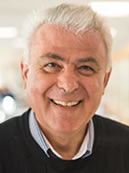 |
Panos Tsakiropoulos, Professor Tsakiropoulos studied Mining and Metallurgical Engineering at the National Technical Univ. of Athens (1975, MSc), he earned his MMet (1976) from Univ. of Sheffield and PhD (1979) and was awarded the Brunton Medal and Prize in 1981. He joined as a Lecturer the Univ. of Surrey in 1986 where he was promoted to Reader in Metallurgy in 1991 and appointed to the Chair of Metallurgy in 1996. In 1995 he was awarded the Elegant Work Prize by the Institute of Materials, UK. He returned to the Univ. of Sheffield in 2006 as Professor of Metallurgy and POSCO Chair in Iron and Steel Technology. In Sheffield he was Director of IMMPETUS (Institute of Microstructural and Mechanical Process Engineering) 2008-2012 and Director of the Advanced Metallic Systems Centre for Doctoral Training 2008-2016. He and his research group are members of the EPSRC-Rolls Royce Research Partnership (2009-2019). He has been member of the European Turbines Network, numerous metal science committees in the UK, the Titanium and Refractory metals committees of TMS, and member of the Benchmarking Group for Materials for the Quality Assurance Agency for Higher Education in the UK. He has published more than 230 refereed papers in international journals and has 8 patents. He has supervised 54 PhD students, 32 MSc students and 10 postdoctoral researchers. Since 1992, his research has focused on the development of new Nb alloys for aerospace applications with major funding from Rolls-Royce plc, the Engineering and Physical Sciences Research Council of the UK (EPSRC) and the European Union. |
Panos Tsakiropoulos
Department Materials Science and Engineering, The University of Sheffield, UK
Abstract
Targets to be met by aviation by the year 2050, known as “Flightpath 2050”, require reductions (a) of aircraft CO2 emissions by 75% per passenger kilometre, (b) of aircraft noise by 65% and (c) of NOx (oxides of nitrogen) emissions by 90%. The use of advanced composite materials in future aircraft structures will contribute towards meeting these targets. Performance targets of future aero-engines have been revised to meet these significant reductions in harmful emissions. The latter could be met if there were materials available that would enable the engines to operate with significantly higher turbine entry temperatures in the range 1850 ˚C to 1900 ˚C. New materials with capabilities beyond those of Ni-based superalloys are required. The search for new materials has considered alloys, ceramics and composites. Particular attention has been given to new materials that utilise the attractive high temperature properties of “ceramic” refractory metal intermetallics. In situ composites exploiting the properties of refractory metal silicides have the capacity to offer a balance of properties to meet performance targets. The presentation will place the development of these in situ composites in the context of the needs of the aerospace industry for new materials and will show how recent advances in understanding the alloying behaviour of the aforementioned phases have made it possible to design and select new alloys with balance of properties that can meet industry set property goals. Examples of Nb-silicide in situ composites will be given. Processing challenges will be considered with emphasis on primary and secondary processing, and on coating systems. The properties of the new materials will be discussed with the focus on fracture toughness, high temperature strength, creep and oxidation resistance.